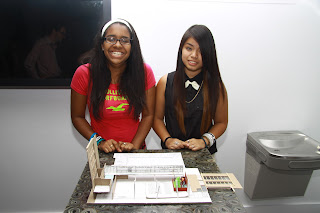The 2012/13 season Opera Annex production of James
MacMillan’s Clemency took place at
the Artists for Humanity (AFH)
Epicenter in February. For twenty years,
AFH has been empowering and employing Boston teens in a uniquely intensive
program of arts, creativity and enterprise. AFH partners youth in small groups
with professional artists/designers to design, create, market and sell art
products.
In preparation for the production, Clemency scenic designer, Julia Noulin-Mérat, worked with AFH youth
artists in the 3-D design studio in a series of workshops during which
participants read the libretto of the opera, completed research and design
sketches, built scale set-models of their own design, and presented their work
to Julia and the Clemency Stage
Director, Andrew Eggart before seeing BLO’s own design for the opera. AFH youth artists also attended special
events with the composer and librettist, visited the A.R.T. Scene Shop to
observe the set build, and attended the Final Dress Rehearsal and performances
of Clemency. Recently, Julia reflected back on her
experience leading the project at AFH.
BLO: Normally,
working as a scenic designer and artist, what do you find intriguing or
inspiring about working with teens?
Julia: I think they come into it with no preconceptions, and
with a very open mind—an uncensored mind.
And their curiosity is different.
How is it different?
What they latch onto.
Sometimes it’s very impulsive, and sometimes it has to do with what is relevant
to them – having gone through [an experience] or something they’ve heard about
and they want to explore that more. The
typical approach is that you start thinking dramaturgically about the context
of the story.
Describe the kind of
energy that young, developing artists bring to this kind of project? How do you respond to it as an artist
yourself, and as someone being given a mentorship role to young people?
My answer to that question would have been completely
different ten years ago, in the sense that social media has completely changed
human interactions. [Teens] are growing
up in a world where they’re constantly attached to their phones. So, to ask them to focus on something is
completely different. You really have to
engage with them.
Does that make your
job harder?
Not harder, but you have to constantly ask them questions,
and be proactive. When I was doing
things like this ten years ago we had more time to process things. Now, you have to be ready to constantly draw
things out of the students.
Why is it important
to expose young people to scenic design and technical theatre?
It gives them a better comprehension of what happens behind
the scenes. And I think it really covers
the basics of multiple subjects. You
start with the text—basic English and literature skills. Then there’s the mathematical aspect of how you
are going to fit everything [in the scenic design] onstage, basic
problem-solving. Then there’s the art
history and appreciation – depending on the approach you take. It’s really exciting for young people to
know that there are jobs out there that do require knowledge in a little bit of
everything, and that change every day. I
remember myself, I had no idea this job existed. [Laughs.]
It’s good to know that there are other kinds of artists. Usually, people hear “artist” and they think you’re
a painter or a sculptor. But art can be
so many different things.
Did you have any
experiences as a teen that inspired you to get involved in set design?
It’s actually kind of funny—I was in pre-Med [laughs] and
one of my friends said, “Julia, you’re seeing plays two to three times per
week. Don’t you think there’s something
to that?” And I was like, “Oh, no, no,
this is just a fun little hobby.” But I
started interning [with a set designer], and I just fell in love with it. And I sat my parents down and said I thought
I would try set design. And they were
very supportive, luckily.
That’s great you had
such supportive parents.
My mom, when I was a kid, did something very smart. She took me to see Bluebeard’s Castle, the play, and then I saw Bluebeard’s Castle, the opera.
It was cool to see the different cross-cultural aspects between the
mediums.
What was your
favorite experience from working with the young artists at AFH?
The fact that they’re already coming from an environment in
which they’re really excited about the arts, and they’re already pre-disposed
and open-minded to experience something new. And at AFH they’re so used to doing all these
art installations for other clients, so they’re coming in with all these tools
already, which is great!
Any final thoughts
about the program at AFH?
I think the exciting thing about this project was that we
embraced their space. Instead of creating
a theatre inside their space, it was more of an art installation than a set—a different
interpretation of design. And they got
to see the whole puzzle of singers rehearsing, the acoustic challenges. It’s really cool for them. It would be one thing to go talk to them and
then show up at the Shubert, which is cool too, but at AFH they could literally
peek downstairs and see the process.





No comments:
Post a Comment